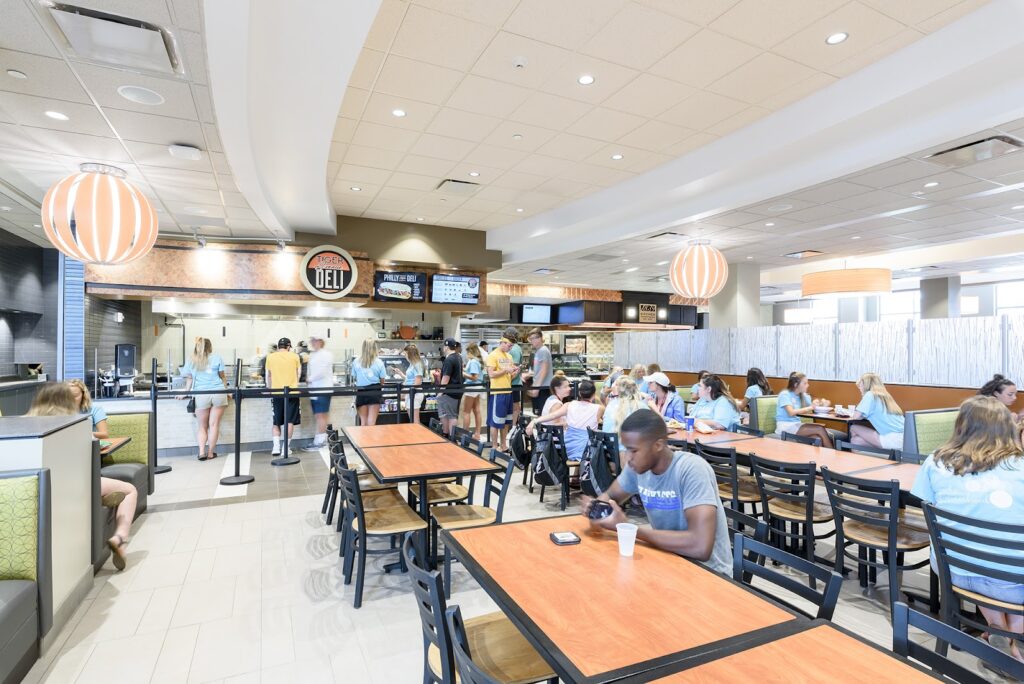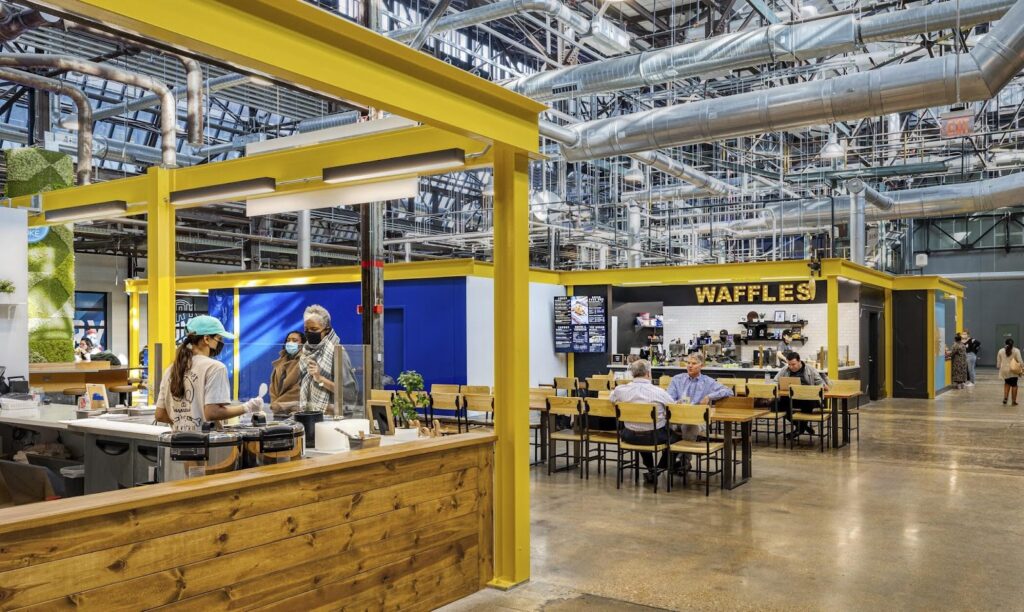In 2024, architecture is trending toward natural, human-centered design. At the same time, technology plays an ever-growing role in realizing this nature-driven aesthetic.
Here are 9 trends the experts at Lawrence Group expect to gain steam over the coming year – and 3 trends we see on the way out.
Biophilic Design
Biophilic design incorporates natural elements like greenery, fire, and sunlight to connect people with nature in the indoor environment.
Decorators have long used plants and natural materials to create a comfortable, welcoming aesthetic. Biophilic design takes that concept a step further.
By incorporating the natural world into the building’s very architecture, biophilic design benefits both people and planet. Examples include large central fireplaces, living walls of greenery or moss, wooden elements like paneling and beams, and indoor-outdoor spaces like balconies, courtyards, and atriums.
Benefits of biophilic design: Exposure to natural elements has been shown to reduce anxiety, lower blood pressure, and enhance attention spans
Smart Building Materials
Proponents of smart building materials envision a future in which materials like self-cleaning paint and self-healing concrete essentially help a building play a role in its own maintenance.
More commonly used smart materials include light-reactive glass and other systems that conserve energy by responding to their environment. For example, the Williams Village East Residence Hall at the University of Colorado Boulder includes skylights that darken or lighten depending on the season and time of day.
In addition, student rooms in Williams Village East have heating and cooling systems that automatically shut off when windows are opened. Vacancy sensors in the rooms turn off lights and adjust the temperature when students leave the room.
Benefits of smart materials: Reduced requirements for human intervention and maintenance, energy efficient
Green Architecture
In 2024, end users care as much about a building’s environmental impact as they do about its look. Led by the commercial sector, green building is expected to grow by more than 9% globally over the next decade.
Green architecture means designing and constructing a building to have minimal negative impact on the environment. It includes everything from a building’s materials to what happens when it has outlived its intended use.
Reused building materials like recycled glass and reclaimed wood may play a part in environmentally friendly design. Architects may also use sustainable new materials like hemp concrete.
Green buildings are designed to continue their climate benefits throughout their lifespan. Using techniques like passive design, architects make optimal use of natural light and ventilation, reducing the building’s energy needs. Sustainable insulating materials and renewable energy sources further lower energy consumption.
Benefits of green architecture: Environmentally friendly, long-term value through energy efficiency
|
|
Community-Centered Design
Community-centered design puts the experience of the people who will use the building front and center. It ensures a building will be functionally accessible and aesthetically enjoyable to diverse groups of people, while prioritizing users’ ability to interact and engage with their environment.
For example, the Epoque Golden luxury apartment community was designed to take advantage of the breathtaking Colorado mountain scenery. Residents can meet their neighbors and strengthen community bonds from balconies and patios or in the many public spaces such as the fitness studio, game room, or pool.
Benefits of community-centered design: Engages the community in the design and use of the buildings in their environment
Adaptive Reuse
Recycling isn’t just for glass bottles and aluminum cans. As interests in environmental awareness and cultural preservation converge, a growing number of organizations are opting for adaptive reuse over new construction.
Adaptive reuse is the practice of adapting an existing structure to a new use. Unlike restoration, which seeks to restore old structures to better serve their original purpose, adaptive reuse reimagines spaces to serve an entirely new function.
Lawrence Group frequently helps organizations renovate historic buildings for new use. Examples include an historic bank turned into organizational headquarters, a tavern located in a former train station baggage claim, and an industrial basement turned speakeasy.
Benefits of adaptive reuse: Faster than building from scratch, revitalizes existing neighborhoods, lower environmental footprint than new construction
Mixed-Use Developments
Rather than sharply segregating neighborhoods into residential, office, and retail, developers in 2024 are finding an increased interest in mixed-use neighborhoods.
Environmentally minded consumers sensitive to traffic pollution are drawn to neighborhoods where they can live, work, and shop without using a vehicle.
Commercial activity in mixed-use neighborhoods tends to be less vulnerable to economic upheaval, such as the sharp drop in demand for office space after the COVID-19 pandemic.
Perhaps driven in part by this, prime office corridors are migrating away from central business districts and into surrounding neighborhoods, where offices mingle with shops, restaurants, and living spaces.
Benefits of mixed-use neighborhoods: Reduce transportation-related pollution, offer residents the ability to live, work, and shop in their own neighborhood, less susceptible to economic instability
|
|
Timeless Architecture
Trends come and go, but some designs are always in vogue.
Timeless spaces that still feel fresh in 2024 have an organic sense of flow. Completely open floor plans have dropped in popularity, but wide arched or cased openings and wide corridors create desirable defined spaces that still leave plenty of room to breathe.
Designs that incorporate neutral colors and natural elements remain classic. Wood, stone, and natural light never go out of style.
Benefits to timeless architecture: Timeless architecture and quality craftsmanship maintain their style without regular renovations and redecorating
AI-Assisted Architecture
In 2024, virtually every industry is talking about artificial intelligence. In architecture, AI tools are opening exciting new doors to collaboration and creativity.
Visualization tools help architects explore creative ideas, while AI assistants take some of the friction out of mundane tasks like research and sorting notes.
Architecture-specific AI tools can help architects get out of the technical weeds of tasks like environmental analysis and code compliance so they can focus on their highest-value task: creative solutions.
Benefits of AI-assisted architecture: Gives architects technical support so they can concentrate on creative problem solving and collaboration
Modular Construction
In modular construction, entire sections of a building are fabricated off-site, then installed at the project location. This technique allows construction in a controlled environment, not subject to increasingly unpredictable weather.
Modules are built to the same codes and standards as conventional buildings. Rather than waiting until sitework and foundations are complete, walls and interior fixtures can be built off-site at the same time, dramatically shortening construction timelines.
Benefits of modular construction: Faster than conventional construction, eliminates the need for onsite material storage
3 Architecture Trends That are Out in 2024
Maximalism
Between the climate crisis, economic upheaval, and political turmoil, the past few years have been tumultuous, to say the least.
The uncertainty felt across much of the globe has led to a sense of restraint in building design. Architects are leaning away from extravagant, maximalist designs in favor of spaces that feel quiet and safe.
Gray Everything
For the past several years, shades of gray have dominated interior design, particularly in commercial spaces.
Gray owes its surge in popularity to its ability to feel cool and serene. But its ubiquity seems to be leaving people sad and craving color.
Expect to see soft, nature-inspired tones in more places. Benjamin Moore and Sherwin Williams both chose blue tones as their 2024 Color of the Year, while the trendsetting Pantone Color of the Year is a warm shade called “Peach Fuzz.”
Cookie-Cutter Commercial Design
Gone are the days when the only difference between one office another was the nameplate on the door. Today’s businesses understand the value of a brand, and they want their spaces to reflect their organization’s personality and culture.
In rented office space, architects can bring in a sense of personality with custom features that are easy to swap out or replace. Bold color schemes, modular walls, and partitions are examples of ways a space can be reconfigured to suit the brand of each tenant.
Designing a Space That Lasts
A well-designed space is functional and beautiful throughout the years, as trends come and go. Lawrence Group listens deeply to our clients’ desires to design buildings that are as practical as they are pretty and as innovative as they are efficient.
Contact us today to start on your next project.
About Lawrence Group
Lawrence Group is a best-in-class design firm using the power of people with great ideas to bring clients’ dreams to life. Founded in 1983, we offer architecture, interior design, master planning, landscape architecture and furniture procurement services to clients across the country.


